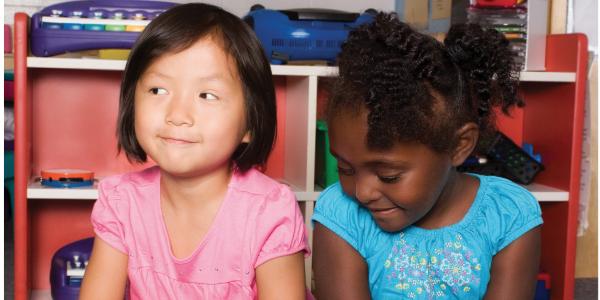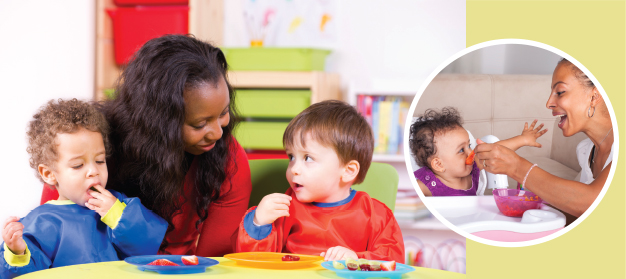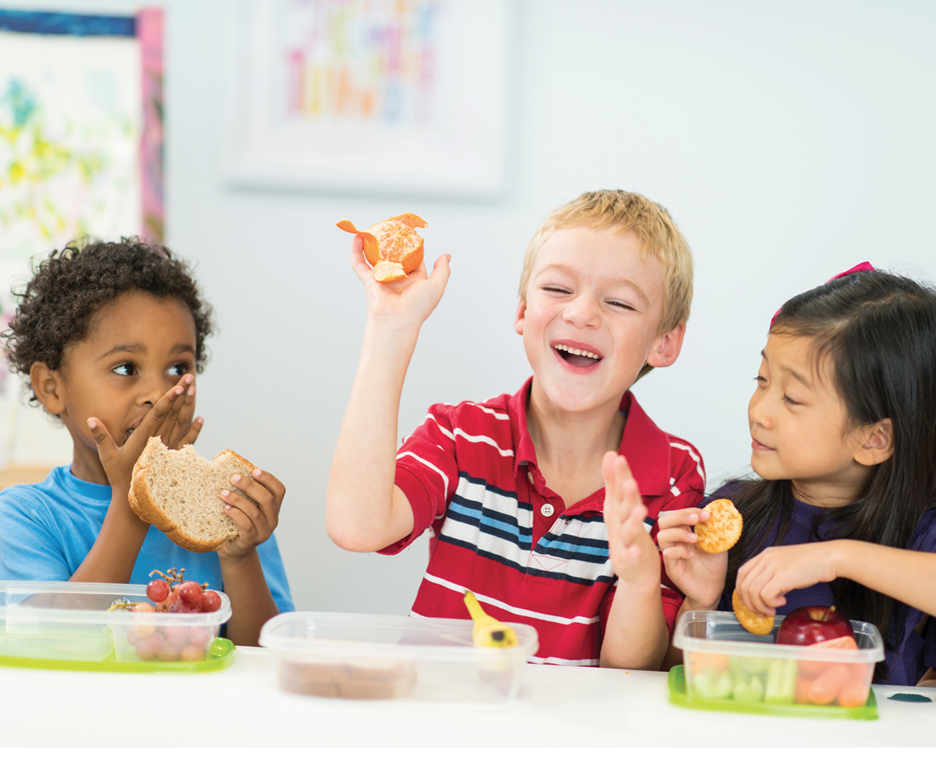Culturally Appropriate Positive Guidance with Young Children

You are here
Three-year-old Emily is singing to a rag doll in the dramatic play area, pretending to rock her to sleep. Ana, also 3, snatches the doll from Emily’s hands. Ana says, “Baby wants sleep!” Upset, Emily says, “It’s my baby! I am rocking her to sleep!” Ana insists that the baby needs to be under the blanket. She lies down with the doll for a second, then jumps up to close the blinds.
At first glance, a teacher may view this situation as a behavioral issue—Ana needs to understand that no one can take another’s toy without permission. While the behavior is important to address, Ana and Emily’s teacher, Ms. Jones, is also aware that young children have a deep understanding of their own cultural routines and a strong desire to follow those routines. While acknowledging that Ana’s method was not appropriate, Ms. Jones realizes that Ana was trying to prevent an uncomfortable situation for the “baby” by putting her to sleep according to the routine in Ana’s home—lying down with the baby in a quiet, dark room.
Young children benefit when teachers and families establish healthy partnerships and define common goals for children.
To help all of her students understand that everyone has different cultural practices at home, and that all of them are to be respected, Ms. Jones decides to begin an exploration of the different ways children and families go to sleep. She searches for children’s literature focused on how people go to sleep and chooses Where Children Sleep, by James Mollison; Why Cowboys Sleep With Their Boots On, by Laurie Knowlton; and The Napping House, by Audrey Wood. As Ms. Jones reads these books aloud, she supports the children in exploring the illustrations and comparing their home routines with those in the books. To broaden the discussions, Ms. Jones shows them photographs found on the Internet that depict the bedtime rituals of children from various countries. Many of these photos show how weather, house size and type, and parenting practices influence the ways children go to sleep. Within a few days, Ms. Jones and the children carry the investigation into the dramatic play area, where they pretend to put babies to sleep in hammocks, body wraps, cribs, beds, and sleeping bags, either alone or with dolls representing parents or siblings.
Although it is not possible to transform every incident into an enriching investigation, teachers would do well to follow in Ms. Jones’s footsteps. Many behaviors have cultural roots that teachers can capitalize on to foster each child’s developing identity, share cultural lessons with the whole class, and help children cultivate shared norms for their behavior as students. Research on the experiences of culturally and linguistically diverse young children in early childhood settings implies that what Ms. Jones faced is fairly common: some guidance challenges are based on differences between home and school practices (Rogoff 2003). Teachers like Ms. Jones recognize that some conflicts among children reflect the children’s early understanding of their own cultural scripts (family and community practices and rituals for how things are done) and their limited understanding of others’ scripts.
As teachers provide positive, developmentally appropriate guidance for a particular behavior, they consider the issue through the lens of cultural appropriateness, an important dimension of developmentally appropriate practice (Copple & Bredekamp 2009). This lens may encompass family traditions, religious beliefs, community etiquette, social class, and contextual differences (such as urban, rural, and suburban practices), any of which may be a source of possible conflict between children. As they choose guidance strategies, teachers help children understand that their peers’ play and behavior may look and feel different from their own because of different cultural practices, and they support children as they gradually learn to negotiate different sets of expectations between home and early education settings.
Early childhood educators may find that the expectations of some children and families they serve do not fit their framework for positive guidance. Culturally appropriate positive guidance requires educators to understand and mediate differing views on child guidance between home and school contexts.
Understanding family perspectives and goals for child development
One important aspect of child development is children’s increasing adoption of and participation in family and community routines and practices (Rogoff 2003). Some cultural practices, such as authoritarian parenting styles, may seem to conflict with an education program’s philosophy and curriculum or with a practitioner’s own perspective. (See “Understanding Family Practices that Clash With Center Principles.”) However, by respecting families’ viewpoints and contexts, practitioners support family cohesion, which is an essential aspect of social and emotional development in young children, especially children whose home culture might be very different from the typical US school culture (Isik-Ercan 2012).
Understanding Family Practices that Clash with Center Principles
Some family practices may pose guidance challenges in early learning programs.
Family cultural practice
- Spoon-feeding toddlers while sharing stories and songs with them (not allowing young toddlers to practice self-feeding)
-
Performing physical care tasks and practices for children, such as tying their shoes or putting their coats on them

Center principle
- Encouraging young children’s self-care practices and self-help skills in order to foster independence
Interpretation of a family practice
- Spilling and wasting food is unacceptable and disrespectful of people’s efforts/nature’s bounty/animals in the food chain
- Feeding rituals and other physical care customs are essential elements in establishing physical and emotional attachment between caregiver and child and are shared cultural rituals that signify love
Young children benefit when teachers and families establish healthy partnerships and define common goals or developmental outcomes for children. When early childhood practitioners inquire about particular family practices, they are likely to find that both parties have many similar goals, including helping children develop skills such as social competency, altruism, sharing, collaboration, respect, and confidence (Isik-Ercan 2010). While these goals look similar across cultural contexts, the tools and methods each party uses for positive guidance might look quite different. Therefore, practitioners may need to engage with families in collaborative problem solving when conflicts arise (Copple & Bredekamp 2009), rather than applying one guidance method for all children. The following example illustrates how Mr. Garcia, a preschool teacher, used culturally appropriate guidance.
When 5-year-old Yen-Ting sees 4-year-old Max playing with his cereal and dropping it on the floor, Yen-Ting quietly says, “Shame on you.” Max shouts, “Go away!”
 Yen-Ting is upset by Max’s reaction. He was reminding Max about the no-playing-with-food rule, like an older brother might. Max, offended by the intrusion in his privacy, thinks Yen-Ting should not reprimand him, as he is not an authority figure. This exchange reveals the differences in the cultural perspectives these children have gained in their family contexts.
Yen-Ting is upset by Max’s reaction. He was reminding Max about the no-playing-with-food rule, like an older brother might. Max, offended by the intrusion in his privacy, thinks Yen-Ting should not reprimand him, as he is not an authority figure. This exchange reveals the differences in the cultural perspectives these children have gained in their family contexts.
Mr. Garcia is knowledgeable about both families’ expectations for their children. For example, from conversations with Yen-Ting’s family, he knows that saving face to avoid public shame and preserve group harmony is an important Confucian principle. Instead of bringing both children together to address the issue—a common conflict-resolution technique—Mr. Garcia discreetly speaks individually to the children to help each understand the other’s perspective. He explains to Max that Yen-Ting is trying to be considerate by quietly reminding him of a rule; he tells Yen-Ting that even though he was whispering, his words sounded harsh to Max. Mr. Garcia suggests that in the future, Max consider whether his classmates are trying to help him, and Yen-Ting consider saying, “If you drop food on the floor, the floor will be dirty and wet,” and let Max make the choice. Although the boys did not engage in conflict resolution in this instance, they are now more aware of each other’s intentions.
When they use culturally appropriate positive guidance, practitioners like Mr. Garcia support the development of children’s bicultural identities, honoring both their family and community context and their school context. Some home practices are directly associated with the core of children’s cultural identity and so should be respected. By respecting such practices—even when not agreeing with them—educators promote children’s healthy social and emotional growth. In offering guidance, Mr. Garcia protected the families’ position as primary caregivers and guides in their children’s social and emotional growth, as suggested in the NAEYC “Code of Ethical Conduct” (2005), in particular, Ideal I-2.6—“To acknowledge families’ childrearing values and their right to make decisions for their children.”
Making a program’s structure more accommodating
Another way to encompass varying perspectives on child guidance is to provide a flexible program structure that accommodates individual needs. For instance, children who come from homes where their schedules flow with the natural rhythms of their attention span and engagement and with their own awareness of their physical needs, might struggle in a more structured classroom environment. Simple arrangements such as making a snack available at a corner table, where children can sit whenever they need a break, might offer a natural respite and sense of control for children who might be frustrated with and resistant to what they perceive as unnatural transitions and abrupt changes.
Using Sociocultural Conflicts Among Children as Teachable Moments: A Case Study
Guidance challenges stemming from cultural and linguistic diversity can be viewed as opportunities for practitioners to address children’s growing social abilities. An early childhood practitioner can help culturally diverse children understand norms and social expectations by mediating peer relationships. The following story illustrates such a process.
Four-year-old Abdi was a newly arrived refugee from Somalia. On his first day at a church-located early childhood center, he ran wildly down a hallway, followed by his mother, who was attempting to stop him. Teachers were startled to see a child making so much noise and running freely in the orderly and quiet learning environment. Interacting with Abdi in the following days, Ms. Miller, the preschool preservice teacher, and I learned that he was extremely nervous in his new, all-white preschool class and wanted to leave, so running seemed to him like a good solution.
By the following week, however, Abdi was settling in, following directions and seeming more at ease with his peers. Ms. Miller and I often observed Abdi gently touching his friends on their shoulders and heads while participating in whole-group games and engaging in rough-and-tumble play on the playground—sometimes to his peers’ dismay. Ms. Miller and I worked with Abdi and his peers to explore social expectations in his new environment.
For example, Abdi’s peers had a much larger sphere of personal space than Abdi was accustomed to, so he would often talk more closely or touch more often than they preferred. Although his peers protected each other’s personal space, they could not explain to Abdi how or why they felt Abdi was violating it.
Being careful to not put Abdi on spot, Ms. Miller and I facilitated this negotiation of personal space by helping all the children understand some expectations in our early childhood classroom. We discussed and role-played rules about private space, noise-level expectations, and limited physical contact. Using persona dolls in story lines that children developed and explored, we guided the children’s discussion of why, how, and when touching friends may or may not be a good idea in the school setting and other settings. Like Ms. Jones’s investigation of sleeping routines, we explored the notion of personal space as a fascinating cultural difference—not as something that could be right or wrong.
We also helped children understand that some nonverbal clues, such as smiling or making eye contact, may, in certain contexts, mean discomfort rather than agreement or contentment. These practices provided children with tools to notice subtle cues before unwelcome interactions turned into negative reactions.
At the same time, in collaboration with the classroom teacher, Ms. Miller and I helped the individual children who were most reactive to Abdi realize that when Abdi kept touching a child, it meant he was showing his affection for and interest in that child. Discussing differences in children’s actions supported all children’s general perspective-taking abilities. In the next week, we observed several children explaining to each other what a peer meant when he or she said or did something that might be misunderstood.
Children’s flexibility and resilience in negotiating multiple learning contexts
When it comes to forming bicultural identities, children are remarkably adaptive.For example, a case study of a preschool classroom found that although teachers and parents of culturally diverse children held different beliefs and practices about literacy learning, appropriate language for interactions, and social norms, the children were successful in navigating both the home and classroom contexts (Fluckiger 2010). They used strategies such as following the peer culture rules they observed when entering ongoing play or showing their knowledge of the alphabet, so that other children sought out their knowledge and showed greater acceptance of them. Most young children become skilled at analyzing the cultural codes and expectations in the classroom (Avgitidou 2001; Kim 2014). Rather than anticipate sociocultural conflict among children when cultural incongruences arise, teachers can observe and build on children’s established and emerging abilities to adjust to different contexts.
Understanding peer culture and fostering classroom community
Peer culture—“the stable sets of routines, artifacts, values, and concerns that children produce and share with each other” (Corsaro 2012, 489)—is an important component of classroom culture. Teachers may gain valuable insights when they examine various elements of the peer culture in their classrooms and use children’s interactions to establish positive guidance. One study (personal communication with Elena Bodrova, April 30, 2013) observed that when provided with autonomy to do so, preschool children first monitor and regulate their peers’ behaviors before they turn to themselves and apply the same strategies, aligning with Vygotsky’s (1978) statement that mental skills begin as social processes and then become internalized. Social interaction with peers during play provides children with necessary feedback to reconsider their actions. Even though their home practices might be different, Chen (2012) documented children’s flexibility to use feedback gathered from those peer interactions. Therefore, creating a safe space in which children can monitor each other and thus better internalize guidance expectations can help teachers foster a close-knit classroom community.
When practitioners attend to the peer culture in their classrooms, they may notice that children are curious to explore their peers’ beliefs and behavioral norms, which might lead, at times, to what may seem like discriminatory behavior (Derman-Sparks & Edwards 2010) and—when not addressed—to guidance challenges. For example, when Susan, who had never been in preschool before, shouted to her peers, “No boys allowed in our kitchen!,” she was drawing on roles she was familiar with—a homemaker woman and a breadwinner man. Having gotten to know Susan, her teacher saw that she was thinking through these roles and wanted to provoke the boys to see if they agreed with such roles. When practitioners understand children’s curiosity and the challenge of digesting multiple viewpoints, they may be encouraged to provide space for children to explore differences and variations in social or individual practices through dramatic play, instead of viewing differences as offending and limiting this crucial time for children to negotiate their actions and beliefs.
Conclusion
For many children, preschool is their first significant opportunity to learn about routines and behaviors that are different from their home life. Early childhood practitioners should keep in mind that differences in cultural routines can be just as hard—if not harder—to adjust to as differences in when and where children are eating and napping. To examine their cultural assumptions, educators should challenge themselves by taking another colleague’s or a family’s perspective on child guidance (Gonzalez-Mena & Shareef 2005). Agreement may not always be possible, but understanding and respect can always grow. As practitioners develop their cultural knowledge, they will be better able to identify opportunities for learning, just as Ms. Jones and Mr. Garcia did.
References
Avgitidou, S. 2001. “Peer Culture and Friendship Relationships as Contexts for the Development of Young Children’s Pro-Social Behaviour.” International Journal of Early Years Education 9(2): 145–52.
Chen, X. 2012. “Culture, Peer Interaction, and Socioemotional Development.” Child Development Perspectives 6(1): 27–34.
Copple, C., & S. Bredekamp, eds. 2009. Developmentally Appropriate Practice in Early Childhood Programs Serving Children From Birth Through Age 8. 3rd ed. Washington, DC: National Association for the Education of Young Children (NAEYC).
Corsaro, W.A. 2012. “Interpretive Reproduction in Children’s Play.” American Journal of Play 4(4): 488–504. http://files.eric.ed.gov/fulltext/EJ985602.pdf.
Derman-Sparks, L., & J.O. Edwards. 2010. Anti-Bias Education for Young Children and Ourselves. 2nd ed. Washington, DC: NAEYC.
Fluckiger, B. 2010. “Culture-Switching in Different Worlds: Young Children’s Transition Experiences.” Australasian Journal of Early Childhood 35(4): 101–08.
Gonzalez-Mena, J., & I. Shareef. 2005. “Discussing Diverse Perspectives on Guidance.” Young Children 60 (6): 34–38.
Isik-Ercan, Z. 2010. “Looking at School From the House Window: Learning From Turkish-American Parents’ Experiences With Early Elementary Education in the United States.” Early Childhood Education Journal 38 (2): 133–42.
Isik-Ercan, Z. 2012. “In Pursuit of a New Perspective in the Education of Children of the Refugees: Advocacy for the ‘Family.’” Educational Sciences: Theory and Practice 12(4): 3025–38.
Kim, J. 2014. “‘You Don’t Need to Be Mean. We’re Friends, Right?’ Young Korean-American Children’s Conflicts and References to Friendship.” Journal of Early Childhood Research 12 (3): 279–93.
NAEYC. 2005. “Code of Ethical Conduct and Statement of Commitment.”Position statement. www.naeyc.org/files/naeyc/file/positions/PSETH05.pdf.
Rogoff, B. 2003. The Cultural Nature of Human Development. New York: Oxford University Press.
Vygotsky, L.S. 1978. Mind in Society: The Development of Higher Psychological Processes. Cambridge, MA: Harvard University Press.
Photographs: 1, 2, 3, 4, 5, © iStock; 6, © Julia Luckenbill
Zeynep Isik-Ercan, PhD, is an associate professor and program coordinator in the early childhood teacher education program at Rowan University, in Glassboro, New Jersey. Zeynep’s research focuses on cultural diversity and best practices in early childhood education. [email protected]